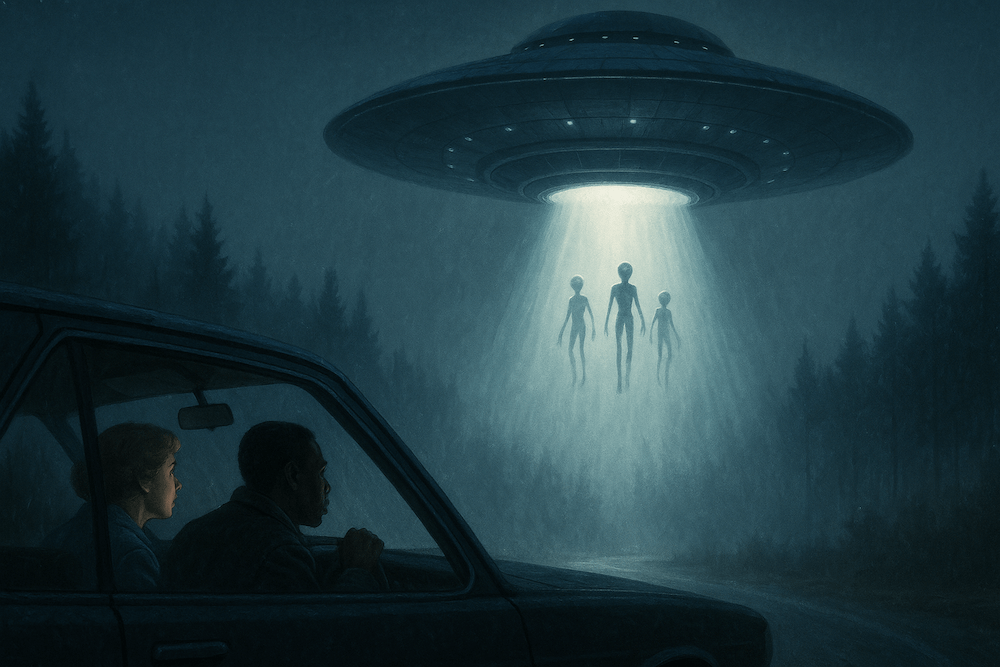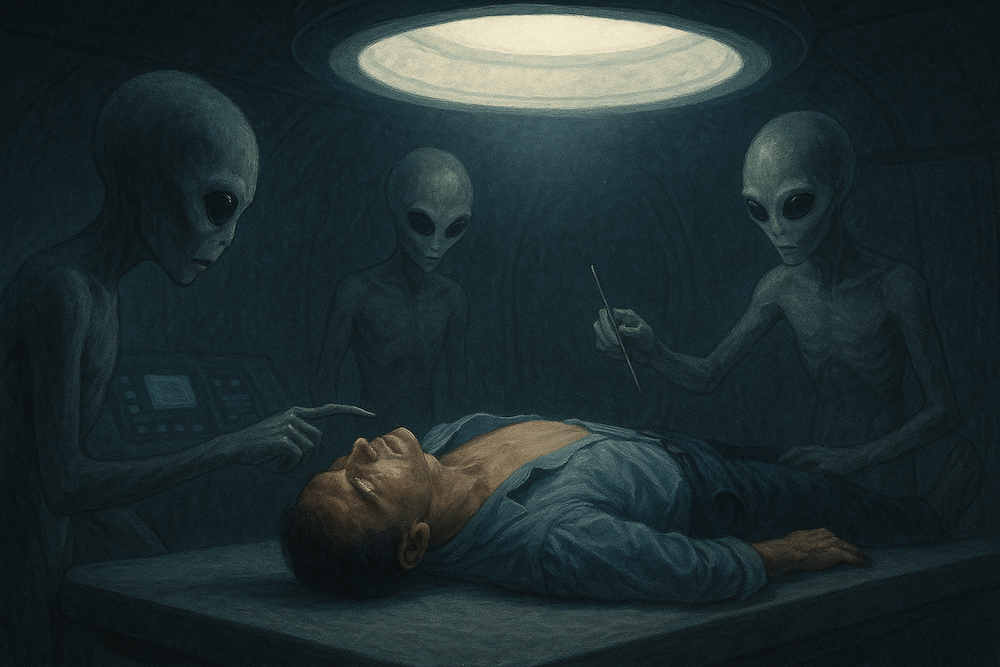Betty and Barney Hill were driving home through New Hampshire's White Mountains on a night in September 1961 when they saw a strange light following their car. What happened next would go down in history as the most famous case of alien abduction and set the standard for many others. But what really went down that night? And why do so many people all over the world keep saying they have had similar experiences?
The phenomenon of alien abduction occupies a compelling nexus of science, psychology, culture, and the enigmatic. These experiences warrant rigorous investigation, whether they signify authentic encounters with extraterrestrial intelligence or unveil significant insights into human consciousness and memory. This study looks into the documented cases, scientific research, psychological explanations, and the mystery that still fascinates both believers and skeptics.

The Beginning of a New Myth
Before 1961, people saw UFOs a lot, but reports of abductions were rare and didn't have the specific details that would later become standard. Everything changed after the Betty and Barney Hill case. The Hills were an interracial couple who lived in Portsmouth, New Hampshire. They were both involved in civil rights work and were well-respected in their community. Barney worked for the postal service and volunteered a lot with the NAACP. Betty was a social worker who worked with child welfare cases.
The couple said that after they got back from a trip to Canada on September 19, 1961, they saw a bright object in the sky that seemed to follow them along Route 3. When Barney got out and looked through binoculars, he saw what looked like a structured craft with people inside. He was so scared that he ran back to the car, and they sped away. The couple heard strange beeping sounds, felt sleepy, and then found themselves thirty-five miles down the road with two hours of time they couldn't explain.
When they got home at dawn, they found strange things. Their watches had stopped working. There was pink powder all over Betty's torn dress. Barney's shoes had scuffs on them that weren't normal. Most disturbingly, there were shiny concentric circles on their car's trunk that caused a compass needle to spin wildly when brought near. The Hills told the Air Force about what happened right away, but they left out a lot of details because they were afraid of being made fun of.
In the months that followed, Betty had vivid, recurring nightmares about medical exams on a spaceship. The mental strain got so bad that they went to see Dr. Benjamin Simon, a well-known psychiatrist who was an expert in hypnosis, two years later, in 1963. Betty and Barney both remembered very similar experiences of being taken aboard a ship and having humanoid beings with big eyes and gray skin examine them medically during separate hypnosis sessions.
The Abduction Phenomenon Takes Hold
After the Hill case, reports of aliens taking people went through the roof, especially in the US. From the mid-1970s to the 1990s, thousands of people told similar stories. The fact that these reports were the same from different people who had the same experience made them the most convincing evidence for the phenomenon and the most suspicious thing about it.
In November 1975, Travis Walton, a forestry worker in Arizona, reportedly went missing for five days after being hit by a beam of light from a disc-shaped object that was hovering above him. This is one of the most well-known cases. Six of his coworkers saw the first meeting and said that Walton walked up to the craft and was knocked to the ground by a blue-green beam. Then, the whole crew ran away in fear. Five days later, Walton was found on the side of the road near Heber, Arizona. He said he had been on an alien spaceship and talked about medical procedures and meeting both small gray beings and tall human-like beings.

There was a lot of debate about the Walton case. Philip J. Klass, a science writer, and other skeptics pointed out that Walton's logging crew was way behind schedule on a government contract and would have to pay fines. They said that the kidnapping was a good reason. Also, just two weeks before the supposed kidnapping, NBC showed "The UFO Incident," a movie about the Hill case that was made for TV. Walton had seen the movie and talked about the chance of being taken on board a flying saucer.
The Harvard Psychiatrist Who Believed
Dr. John E. Mack, a professor of psychiatry at Harvard Medical School, did more than anyone else to make claims of alien abduction seem real in the academic world. Mack was not a fringe figure. He started the psychiatry department at Cambridge Hospital and was its head from 1977 to 2004. In 1977, he won the Pulitzer Prize for his biography of T.E. Lawrence. The scientific community was shocked by his choice to take claims of abduction seriously.
Mack's trip into this controversial area began in January 1990 when he met Budd Hopkins, a New York artist and author who had looked into hundreds of abduction cases. At first, Mack was doubtful and thought that claims of abduction "must be some kind of mental illness." But after talking to dozens of people who said they had these experiences, he became sure that something real was happening.
Mack was most impressed by how similar the detailed stories were from people who couldn't talk to each other and how real their feelings were. Mack talked to about 200 people who thought they had been abducted between 1990 and his death in 2004. He then wrote two books on the subject that caused a lot of controversy: "Abduction: Human Encounters with Aliens" in 1994 and "Passport to the Cosmos" in 1999.
The Scientific Counter-Narrative
Mack and a few other researchers supported the idea that aliens abduct people, but the larger scientific and medical community came up with other explanations based on psychology, neurology, and cognitive science. The most convincing of these explanations is based on two well-known things: sleep paralysis and the creation of false memories.
The cognitive and motor parts of REM sleep become out of sync, which causes sleep paralysis. The brain basically paralyzes the body during normal REM sleep so that people don't act out their dreams. Sleep paralysis happens when a person wakes up before the paralysis goes away. It can be very scary to go through. The person is awake and aware, but they can't move or talk at all. This can last for a few seconds or a few minutes.
Sleep paralysis often includes vivid hypnopompic hallucinations, which are sensory experiences that happen when you wake up from sleep. These can be visual hallucinations of people in the room, auditory hallucinations of buzzing or humming sounds, tactile sensations of pressure on the chest or being touched, and kinesthetic sensations of floating or flying. It's very common to feel like there is an evil presence around you. About 25% of people around the world have had sleep paralysis at least once, and about 5% have had the full range of paralysis and hallucinations.
Researchers at Harvard, led by psychologist Richard McNally and Susan Clancy, looked at people who thought they had been taken by aliens and found a strong link to sleep paralysis. In a study that came out in 2005, McNally and Clancy looked at ten people who said they had been abducted and had episodes of sleep paralysis where they thought they saw aliens. The sensory experiences during sleep paralysis closely resembled abduction narratives: vivid lights, buzzing noises, immobility, sensations of levitation, the presence of figures, and even the feeling of being touched or probed.
The Cultural Side
The increase and decrease of reports of alien abductions is closely linked to changes in culture and how the media portrays them. Sociologists and anthropologists assert that abduction narratives flourished predominantly in English-speaking nations, especially the United States, reaching their zenith during particular intervals aligned with UFO-related media.
Before the Betty and Barney Hill case got a lot of attention, reports of abductions were rare and didn't have the specific details that are now standard. Reports skyrocketed after "The Interrupted Journey" came out in 1966, and even more so after the TV movie version in 1975. The details that the Hills gave about what happened were very similar in later accounts. These include the medical examination room, the focus on reproductive systems, the gray-skinned beings with big eyes, and the ability to communicate telepathically.
The X-Files TV show, which ran from 1993 to 2002, both reflected and fueled people's interest in alien abduction. The show was at its best during the time when most abduction reports were coming in. As the series came to an end and the media lost interest, the number of reported abductions dropped a lot. By the middle of the 2000s, alien abduction was no longer a common topic of conversation.
The Effects on the Mind
No matter where they come from, people who think they've been abducted have very strong psychological effects. Richard McNally, a researcher at Harvard, did physiological studies on people who talked about their abduction experiences. He looked at their heart rates, skin conductance, and other signs of stress. The results were shocking: people who had been kidnapped showed stress responses that were as strong or stronger than those of veterans with PTSD talking about traumatic war experiences.
People often use this finding as proof that abductions really happen. If these were merely fantasies or fabricated memories, the rationale posits, why would they elicit such intense physiological stress responses? But McNally's interpretation is more complex. The physiological responses illustrate the authentic emotional influence of belief, rather than the veracity of the events believed. Individuals who genuinely believe they have been abducted react as if they have undergone genuine trauma, as they have psychologically endured trauma.
The Drop in Reports of Abductions
One of the most interesting things about alien abductions is that they are becoming less common. Reports of alien abductions have dropped a lot since they peaked in the 1990s. There are probably a number of reasons for this trend.
Smartphones are so common now that almost everyone has a camera that can take pictures and videos all the time. It has become harder to believe claims about alien ships or abductions because there is no verifiable footage of either happening, even though billions of cameras are always on. The question "where are all the smartphone videos?" has become harder and harder for believers to answer in a way that makes sense.
The internet changed the way information is shared. Before the internet, people who had strange experiences might really have wondered if they were the only ones. It's easy to find groups online today that talk about sleep paralysis, false memories, and mental explanations for strange experiences. You can easily find other ways to make sense of strange things that happen.
Conclusion: Multiple Truths
The phenomenon of alien abduction defies straightforward conclusions. The majority of scientific evidence indicates psychological and neurological explanations: sleep paralysis understood through cultural lenses, false memories generated through suggestible mechanisms, and the significant influence of belief and communal validation. These explanations elucidate the majority of reported cases without necessitating extraordinary assumptions.
But the human side of the event needs to be respected. Many people have said these things with real conviction and strong feelings. Even if the literal reality is still up for debate, their psychological reality can't be ignored. The experiences have changed lives, brought people together, and made people think deeply about memory, consciousness, and the limits of human experience.
The phenomenon of alien abduction elucidates significant truths regarding human psychology. It shows how memory can change, how cultural stories can change how we think about things, how suggestion and expectation can change how we think, and how deeply we need to find meaning in scary or confusing events. These insights extend their significance well beyond the particular issue of extraterrestrial contact.
Ultimately, the phenomenon of alien abduction may reveal more about ourselves—specifically, how we construct reality, interpret experiences, create meaning, and confront the vast and enigmatic universe we inhabit. That one idea is enough to make the phenomenon worth studying more, even if aliens were never involved.
References
- Mack, J.E. (1994). Abduction: Human Encounters with Aliens. Charles Scribner's Sons.
- R.J. McNally & Clancy, S.A. (2005). Sleep Paralysis, Sexual Assault, and Extraterrestrial Abduction. Transcultural Psychiatry, 42(1), 113–122.
- Clancy, S.A., McNally, R.J., Schacter, D.L., Lenzenweger, M.F., & Pitman, R.K. (2002). People who say they were abducted by aliens have memory problems. Journal of Abnormal Psychology, 111(3), 455–461.
- Fuller, J.G. (1966). The Interrupted Journey: Two Lost Hours on a Flying Saucer. Dial Press.
- M. Bowman (2023). The Abduction of Betty and Barney Hill: Alien Encounters, Civil Rights, and the New Age in America. Yale University Press.
- T.E. Bullard (1987). UFO Abductions: The Measure of a Mystery. Fund for UFO Research.
- G. Eghigian (2024). After the Flying Saucers Came: A Global History of the UFO Phenomenon. Oxford University Press.
- G. Perrotta (2021). Clinical evidence regarding the phenomenon of Alien Abduction. Annals of Psychiatry and Treatment, 5(1), 107–115.
- French, C.C. (2005). Abductions by aliens. In Tall Tales About the Mind and Brain (pp. 147–162). Oxford University Press.
- R. Sheaffer (1998). UFO Sightings: The Evidence. Prometheus Books.
